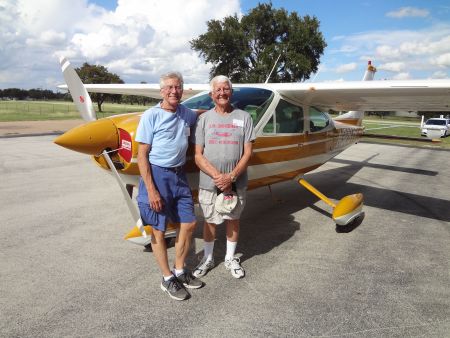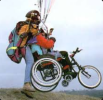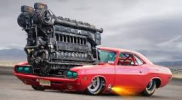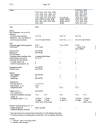This is actually what I thought they meant.Confirmed: Cherokees don't float.
You are using an out of date browser. It may not display this or other websites correctly.
You should upgrade or use an alternative browser.
You should upgrade or use an alternative browser.
172/Cherokee gotchas
- Thread starter ateamer
- Start date
- Joined
- Mar 15, 2016
- Messages
- 4,849
- Display Name
Display name:
Ari
True. But Cherokees won't even float if you are 50 knots over Vref over the fence.On landing Cessna's only float if a pilot is fast on short final and over the fence. 50 knots over the fence and chop power and land on your spot.
Dan Thomas
Touchdown! Greaser!
- Joined
- Jun 16, 2008
- Messages
- 11,299
- Display Name
Display name:
Dan Thomas
The 172M was the best of the legacy 172s. But most models have their weak spots. The horizontal stabilizer's front spar cracks and breaks due to pilots pushing down on it to lift the nosewheel to turn the airplane on the ground. The lower aft doorposts crack at a small radius where they join the landing gear box aft bulkhead. Taxiing over rough ground, or landing in a crab, does that. Cessna has a gusset kit to fix it, but it's a pain to install. On some later 172Ms the bend radius of the front doorposts was a bit tight, and the door hinges caused cracking there as the door was pulled shut against the door seal. More pain to fix. Better to shim those hinges to make door closure easier. The bulkhead at the aft end of the main baggage compartment cracks in its lower inboard flange; that's caused by flexing of the fuselage with rudder input. That big rear window did that by removing so much rigidity of the original fuselage tube. The aileron cables fray at the crossover above the headliner where they pass over small nylon pulleys that don't turn readily, and any dust in there embeds in the nylon and grinds away at the cable. If the airplane has ever been on floats, the wing struts may be cracked through the big rivets that hold the strut lugs in place. And if it was built with all the floatplane stuff, it has stainless control cables that fray and fatigue far too easily. All of the 172R/S models have stainless cables. 172s made from 1968 to the earlier M models had engine mount cracking issues at the lower crossover tube welds. Cessna put finger patches there and stopped that.What gotchas do I need to be especially aware of? I know of the PA-28 spar issue, the flat gear corrosion/cracking possibility on older 172s, Cessna wing carry-through corrosion issues, flap tracks, and seat tracks. What other potentially expensive/hazardous things should be especially looked for?
Yes, easy to get in and out. But that spar carrythrough MUST be inspected properly, corrosion dressed out, and checked with eddy current to confirm minimum thickness requirements and that there are no hidden pockets of corrosion.Have you considered the Cardinal? It has wide doors, its floor is lower to the ground, and cabin is wider as well. The B models have about the same cruise speed as the 172's I believe. (Don't think you want the A models with the 150 HP engines, but that's just my cursory top of mind thought).
Again, that. One could find the spar bad and end up with a salvage parts airplane. The 177 also has cracking problems with the stabilator mounting bracketry. There's a Cardinal Owners Club that has a good checklist for prospective owners and prebuy mechanics.If you are ever leaning toward a Cardinal, you should pay up for a wing-spar inspection. They are subject to corrosion and are made of unobtanium. I like the cardinal, but it has the spar as its Achilles heel, sadly.
Sorry to be late to the party with the obligatory Grumman Tiger recommendation. It will be closest to the RV in terms of handling like a sports car rather than a '60's Buick sedan, and easier to get into and out of than any but the Cardinal. It will also allow you to fold down the rear seats and easily load a wheel chair or whatever else you want back there. In hot weather you can crack the canopy and get as much cooling air as you can tolerate when taxiing. You can also open the canopy up to about 8 inches in the air at 112 kts or below...which I do on uncomfortably hot days at pattern altitudes (btw, the canopy is metal with windows, so there there is no greenhouse effect like with bubble canopies).
Entry and exit are simple. There's a step behind each wing with a well positioned hand hold on the fuselage to get up onto the wing root, then a step of about 8-10 inches to get over the side wall onto the front seat pan, then a final step down into the front seat well. You can provide assistance from either behind on the right side, or (as I prefer) by reaching over from the pilot's side. Or you can do both by helping the person to get on the wing from behind, then assisting them into their seat from the pilot's side. I suspect that it is as easy or easier than getting into the RV.
Owing an RV, you are probably already familiar with the standard Grumman criticism...that the cabin can get wet when the canopy is opened in a monsoon. That is not a common event, and if it happens, the canopy opening when entering and leaving can be kept small enough that it can be protected by an umbrella.
There is a strong type club and parts support from multiple Grumman specialty sources.
Good luck with whatever you decide.
Entry and exit are simple. There's a step behind each wing with a well positioned hand hold on the fuselage to get up onto the wing root, then a step of about 8-10 inches to get over the side wall onto the front seat pan, then a final step down into the front seat well. You can provide assistance from either behind on the right side, or (as I prefer) by reaching over from the pilot's side. Or you can do both by helping the person to get on the wing from behind, then assisting them into their seat from the pilot's side. I suspect that it is as easy or easier than getting into the RV.
Owing an RV, you are probably already familiar with the standard Grumman criticism...that the cabin can get wet when the canopy is opened in a monsoon. That is not a common event, and if it happens, the canopy opening when entering and leaving can be kept small enough that it can be protected by an umbrella.
There is a strong type club and parts support from multiple Grumman specialty sources.
Good luck with whatever you decide.
MBDiagMan
Final Approach
A baby Beech is a very solid, nicely built airplane and some have two doors. That’s where the positive attributes stop. They’re slow as molasses. Almost as slow as my souped up Cessna 140. They also are known for porpoising and landing difficulty. Due to their solid Beech construction though, they are a neat little plane.
MBDiagMan
Final Approach
I might could get a wheel chair through the door into my Mooney, but it Wouldn’t be easy, especially if done by someone restricted to a wheelchair.Is a Moony’s cabin big enough for a wheel chair? I mean, it’s basically just big enough for two small adults to fly in while laying on their backs……. (I kid, I kid. Little good natured Moony humor here)
I love my Mooney enough to get in and out, even though my wife has trouble since I can’t help her much. I’m 75 years old and my wife is one year younger and we manage. To us, it’s worth the hassle. I mean really!, probably less than 1% of the time dealing with the aircraft is entry/exit. I’ve driven sports cars quite a lot during my life and I’ve always been puzzled when I hear the comments about such cars being hard to get in and out of. So what? Same thing applies. Less than 1% of the time involves that problem, which I’ve never thought was a problem anyway.
ateamer
Pattern Altitude
I got to fly a Tiger once. Fun plane! I had forgotten about them as a possibility. A Tiger will probably be beyond my budget, but what about a Cheetah or Traveller? How is their takeoff and climb performance?Sorry to be late to the party with the obligatory Grumman Tiger recommendation. It will be closest to the RV in terms of handling like a sports car rather than a '60's Buick sedan, and easier to get into and out of than any but the Cardinal. It will also allow you to fold down the rear seats and easily load a wheel chair or whatever else you want back there. In hot weather you can crack the canopy and get as much cooling air as you can tolerate when taxiing. You can also open the canopy up to about 8 inches in the air at 112 kts or below...which I do on uncomfortably hot days at pattern altitudes (btw, the canopy is metal with windows, so there there is no greenhouse effect like with bubble canopies).
Entry and exit are simple. There's a step behind each wing with a well positioned hand hold on the fuselage to get up onto the wing root, then a step of about 8-10 inches to get over the side wall onto the front seat pan, then a final step down into the front seat well. You can provide assistance from either behind on the right side, or (as I prefer) by reaching over from the pilot's side. Or you can do both by helping the person to get on the wing from behind, then assisting them into their seat from the pilot's side. I suspect that it is as easy or easier than getting into the RV.
Owing an RV, you are probably already familiar with the standard Grumman criticism...that the cabin can get wet when the canopy is opened in a monsoon. That is not a common event, and if it happens, the canopy opening when entering and leaving can be kept small enough that it can be protected by an umbrella.
There is a strong type club and parts support from multiple Grumman specialty sources.
Good luck with whatever you decide.
They’re slow as molasses. Almost as slow as my souped up Cessna 140.
True for the early ones with the small engines, not so much with 180 or 200 hp. See the table I posted above.
They also are known for porpoising and landing difficulty.
They demand you be on speed. Hit the numbers and they land just fine. Avoiding a forward CG helps landings a lot (and improves speed).
I got to fly a Tiger once. Fun plane! I had forgotten about them as a possibility. A Tiger will probably be beyond my budget, but what about a Cheetah or Traveller? How is their takeoff and climb performance?
I got to fly @SixPapaCharlie ’s Traveller a few years ago and really enjoyed it. I shopped for one for a while, but couldn’t find an acceptable one in my price range.
I suspect 6PC will say the Travellers are underpowered but lots of people are enjoying them. The Cheetah might be a decent compromise if you can find one.
Huckster79
Pattern Altitude
- Joined
- Nov 22, 2018
- Messages
- 2,393
- Display Name
Display name:
Huckster79
Is a Moony’s cabin big enough for a wheel chair? I mean, it’s basically just big enough for two small adults to fly in while laying on their backs……. (I kid, I kid. Little good natured Moony humor here)
I would definitely think a mid body would be in order if considered at all here. I would think entry would be similiar to a Cherokee. The mid body gets rid of the necessity that backseaters are double amputees
My F is very roomy in the back for a GA plane, my adult sons sit back there and can even recline their seats.
Huckster79
Pattern Altitude
- Joined
- Nov 22, 2018
- Messages
- 2,393
- Display Name
Display name:
Huckster79
I really like my club's Mooney - but, it's not the easiest thing to get into and out of. I wouldn't recommend it in this case. A Cessna Cardinal is probably a better choice - might need some kind of a step stool, but there's a lot of room in the cabin, and nice big doors.
Yea the Cardinal would prob really work well for him! Lino doors! Also the shade of high wing as someone else pointed out is nice if he’s in a hot sunny area.
- Joined
- Apr 5, 2017
- Messages
- 3,893
- Location
- hopefully not at work
- Display Name
Display name:
Meet the Fokkers
- Joined
- Oct 16, 2019
- Messages
- 6,089
- Location
- Atlanta / Marietta
- Display Name
Display name:
Vintage Snazzy (so my adult children say)
There is a almost cult Cardinal Flyers group out there if you haven't looked at it yet. Everything you wanted to know about a Cardinal but was afraid to ask.

IF the fixed gear Cardinal could get up to 130 - 135 knots / had they put the big engine in it, it would have fit nicely between the Skyhawk (entry level Chevy Nova) and the Skylane (Buick Station Wagon). But they tried to make it work with the under powered 150 hp Skyhawk engine and it was to replace, not supplement the most produced plane in the world (true figure - look it up). A few other things, but in short a great concept of a plane never got to really take off.
As it is now, the Cardinal IMHO is a great, wide, comfortable plane that just doesn't quite have the Skylane speed that I need in a fixed gear. But like they say; a true first world problem.

IF the fixed gear Cardinal could get up to 130 - 135 knots / had they put the big engine in it, it would have fit nicely between the Skyhawk (entry level Chevy Nova) and the Skylane (Buick Station Wagon). But they tried to make it work with the under powered 150 hp Skyhawk engine and it was to replace, not supplement the most produced plane in the world (true figure - look it up). A few other things, but in short a great concept of a plane never got to really take off.
As it is now, the Cardinal IMHO is a great, wide, comfortable plane that just doesn't quite have the Skylane speed that I need in a fixed gear. But like they say; a true first world problem.
Last edited:
hindsight2020
Final Approach
- Joined
- Apr 3, 2010
- Messages
- 6,964
- Display Name
Display name:
hindsight2020
As the brits say: "and if my grandmother had wheels, she'd be a bicycle" (brits use that to mean a promiscuous woman btw)IF the fixed gear Cardinal could get up to 130 - 135 knots / had they put the big engine in it,
IOW, the sub 200hp 4 seaters have always been plagued with that power loading problem, it's why the market places a premium on the 230-300hp 4 seat offerings, while the latter's owners think it's some special quality to their toy. It's not. Like the F-4 showed, anything can be "fast" if you throw enough afterburning at it.
- Joined
- Oct 16, 2019
- Messages
- 6,089
- Location
- Atlanta / Marietta
- Display Name
Display name:
Vintage Snazzy (so my adult children say)
The asking prices I'm seeing for 172's are so high that I expect a Tiger will be in the same ballpark. Can't comment on the Cherokees.I got to fly a Tiger once. Fun plane! I had forgotten about them as a possibility. A Tiger will probably be beyond my budget, but what about a Cheetah or Traveller? How is their takeoff and climb performance?
All 3 of the 4 seat Grummans have the same cabins and wings, so handling, space (including baggage space), and entry/exit will be the same. Cheetahs and Tigers benefit from Roy LoPresti's speed mods that give the Cheetah a speed advantage relative to the Traveler.
Cheetahs have a max gross weight 200 lbs less than Tigers, and that impacts their useful load. But the O-320 is about 60 lbs lighter than the O-360 so the net useful load difference is only about 140 lbs. A Cheetah will carry 4 hrs of fuel with VFR reserves, 2 adults and a child with lots of baggage.
The key to good take off and climb performance for the Cheetah is the 160 hp STC that many (probably most) have installed. It consists of larger pistons and cylinders on the O-320. Typically owners do it as part of an overhaul, as the larger parts cost little more than installing standard sized ones. The extra power doesn't add materially to cruise speed, but makes climb performance good (sorry, but I don't have a number).
- Joined
- Oct 16, 2019
- Messages
- 6,089
- Location
- Atlanta / Marietta
- Display Name
Display name:
Vintage Snazzy (so my adult children say)
Love the tiger. A few thoughts though.
It likes long runways. Travel light and don’t go with full fuel. Would never go to a shorter runway, would never consider a grass strip.
It is a ton of fun to fly. It’s a Miata to a Cardinal / Skylane “SUV”. But that also means it gets bounced around a bit. After one X Country trip my wife said “no more of this one - rent the ones with the wings on top”. She would never set foot in a Tiger again.
It likes long runways. Travel light and don’t go with full fuel. Would never go to a shorter runway, would never consider a grass strip.
It is a ton of fun to fly. It’s a Miata to a Cardinal / Skylane “SUV”. But that also means it gets bounced around a bit. After one X Country trip my wife said “no more of this one - rent the ones with the wings on top”. She would never set foot in a Tiger again.
Huckster79
Pattern Altitude
- Joined
- Nov 22, 2018
- Messages
- 2,393
- Display Name
Display name:
Huckster79
Ya know w someone mentioning that mobility may become even a greater challenge as time goes on is probably another reason to consider the cardinal. A Cherokee or even my Mooney suggestion may work now but not a year or two down the road… so that was a good thought someone pointed out
I have been farting around with Mopars since 1976. I have done plenty of engine swaps but never one that big! lolIt's the American Way!View attachment 128816
Last edited:
Needed to be said and correct unless you enjoy buying and selling.Ya know w someone mentioning that mobility may become even a greater challenge as time goes on is probably another reason to consider the cardinal. A Cherokee or even my Mooney suggestion may work now but not a year or two down the road… so that was a good thought someone pointed out
I had wanted to push partners to swap for a cardinal too for the ease of in and out but always one reason or another to keep our clown car enthusiast piper..
Huckster79
Pattern Altitude
- Joined
- Nov 22, 2018
- Messages
- 2,393
- Display Name
Display name:
Huckster79
It did, and it was insightful and thoughtful you mentioned it to him. It’s very easy when you’re in the situation to think the current state will hold. I’m going through it myself as my mom declines… ya get set up for current state and it’s easy to forget the current adaptations are always temporaryNeeded to be said and correct unless you enjoy buying and selling.
I had wanted to push partners to swap for a cardinal too for the ease of in and out but always one reason or another to keep our clown car enthusiast piper..
hindsight2020
Final Approach
- Joined
- Apr 3, 2010
- Messages
- 6,964
- Display Name
Display name:
hindsight2020
ditto for my aging parents and their current housing situation. Big time myopic view, thinking they would be 50 forever. The house is a death trap for 70+ year old bones, several nasty falls already, playing that russian roulette. But I've said my peace and they'll do what they'll do until tragedy strikes and I have to take emer leave and deal with the fallout.
We're def making different arrangements for our own old age, single story homes at a minimum. On the flying end, I sure hope I can keep a medical/basicmed that long, though for me I think once I can no longer go upside down, that'll be my trigger to hang it up.
We're def making different arrangements for our own old age, single story homes at a minimum. On the flying end, I sure hope I can keep a medical/basicmed that long, though for me I think once I can no longer go upside down, that'll be my trigger to hang it up.
Dan Thomas
Touchdown! Greaser!
- Joined
- Jun 16, 2008
- Messages
- 11,299
- Display Name
Display name:
Dan Thomas
Same cylinders. Same cubic inches. Taller pistons to raise the compression ratio from 7.0:1 to 8.5:1 or 9.0:1, depending on model. And that's it.The key to good take off and climb performance for the Cheetah is the 160 hp STC that many (probably most) have installed. It consists of larger pistons and cylinders on the O-320.
Huckster79
Pattern Altitude
- Joined
- Nov 22, 2018
- Messages
- 2,393
- Display Name
Display name:
Huckster79
Same cylinders. Same cubic inches. Taller pistons to raise the compression ratio from 7.0:1 to 8.5:1 or 9.0:1, depending on model. And that's it.
I’m curious, not challenging: wouldn’t taller pistons actually lower overall displacement? As they still would be taller at bottom dead center, right? Or am I thinking wrong?
Bore X stroke determines displacement.I’m curious, not challenging: wouldn’t taller pistons actually lower overall displacement? As they still would be taller at bottom dead center, right? Or am I thinking wrong?
Taller the piston deck height reduces the combustion chamber volume and raises the compression.
2 different things.
Huckster79
Pattern Altitude
- Joined
- Nov 22, 2018
- Messages
- 2,393
- Display Name
Display name:
Huckster79
Bore X stroke determines displacement.
Taller the piston deck height reduces the combustion chamber volume and raises the compression.
2 different things.
Yup, I see where my thinking was off now. I pretty much knew it was, but I got down a rabbit trail in my head on it and took the wrong path
Dan Thomas
Touchdown! Greaser!
- Joined
- Jun 16, 2008
- Messages
- 11,299
- Display Name
Display name:
Dan Thomas



